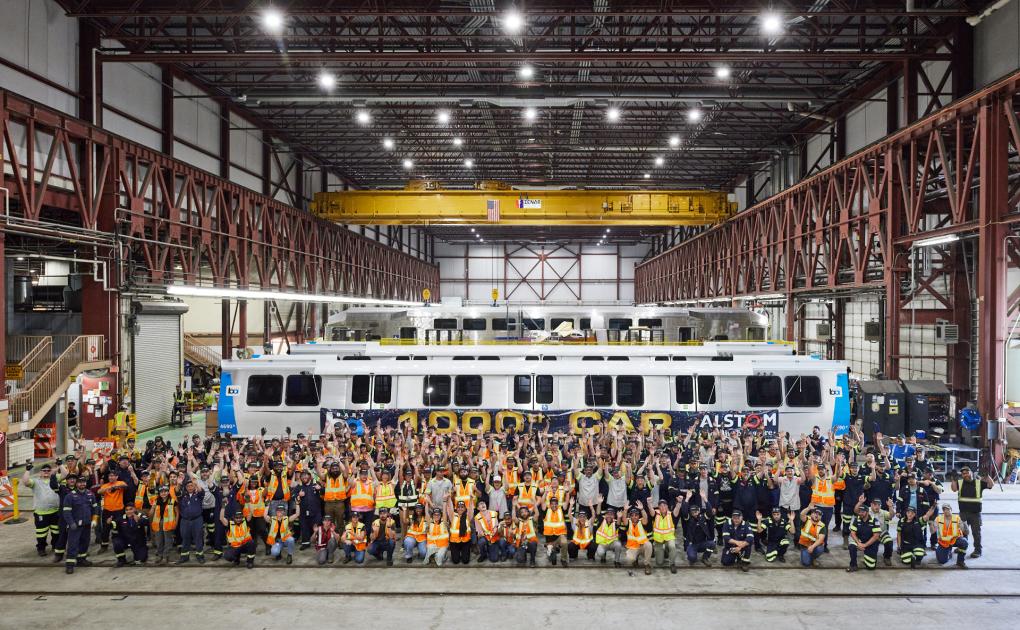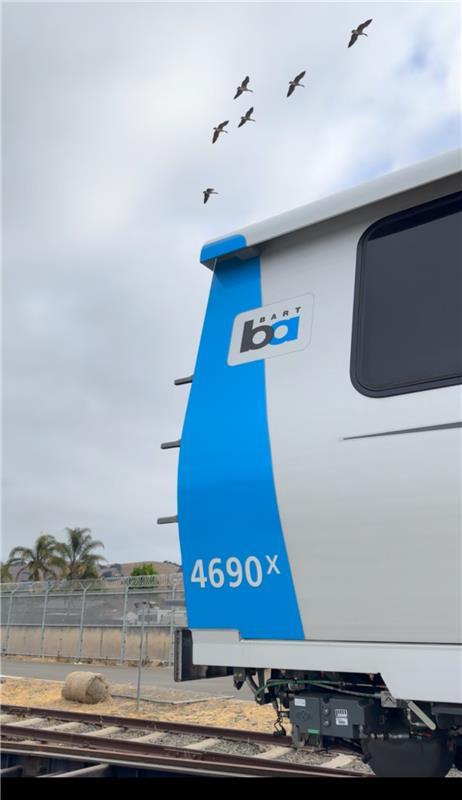The 1,000th Fleet of the Future car was just delivered. Here's what happens next.

On Monday, July 28, BART accepted its 1,000th Fleet of the Future car from Alstom – Car No. 4690 – which pulled onto the Hayward Test Track around 4:30am. The car is pictured above just before departing Alstom's Plattsburgh, New York, facilities.
The car delivery is a major milestone for the Fleet of the Future project, to be completed in 2026 when BART accepts the final 1,129th car.
Last year, the project entered its second (and current) phase when the final car of the original contract was delivered and certified. The project is expected to come in $394 million under budget thanks to a fast-paced production and delivery schedule as well as BART’s decision to have its own highly experienced staff do more of the engineering work in house.
So what happens after a new BART car is delivered? Keep reading...
To BART’s Casey Ungar, the process of accepting and certifying new BART rail cars is of a "very human” nature.
Ungar is a Transportation Supervisor who oversees BART's Hayward Test Track, a 2.25-mile-long stretch of rail where BART accepts, tests, and prepares for service brand-new Fleet of the Future train cars.
The picture he paints of the car certification operation is a romantic one: “Once the cars are delivered via flatbed, we maneuver them onto the test track, and then they kiss the third rail for the first time,” he explained.
Steel meeting steel is just the first step of the robust certification procedure. By the time the cars arrive on BART property from Alstom’s manufacturing facilities in Plattsburgh, New York, they are nearly ready for showtime. But before they carry passengers in the system, the cars must go through a series of tests conducted by specialized BART and Alstom staff.
Many transportation agencies don’t have their own test tracks. To certify new vehicles, they’ll transport them to facilities like the Transportation Technology Center in Pueblo, Colorado, or the vehicles are tested at the supplier's test track where the cars are manufactured.
“BART is the only agency that tests cars like this,” said Ungar proudly. “No other agencies, that I’m aware of, take their cars up to 80 on their own test tracks."
Transportation Supervisor Casey Ungar pictured on a newly accepted Fleet of the Future train car.
On a recent clear-skied day at the test track, Ungar pointed to his left at Car No. 4638, which was resting on the holding track.
This car is a special one for Ungar. A few weeks earlier, Ungar was looking at Reddit when he saw a photo of the same car on the back of a flatbed departing Plattsburgh.
“It was kind of cool for me to have that moment where someone was excited enough to take a photo [of Car 4638] and now here it is,” he said.
“It’s going to be running on mainline come Tuesday, and on Wednesday, it’ll be part of our fleet. And on Thursday, people will be riding in it,” Ungar continued. “It’s really really cool to think of the lifecycle of these cars as something that’s very human, something that starts out so far away but is so personal for so many people and ends up doing such important work in the Bay Area.”

The 1,000th car is pictured on the receiving ramp at Hayward Test Track.
For longtime Train Operator Kirk Paulsen, BART’s railcar certification is entwined with his own lifecycle. Paulsen has been a BART Train Operator for 31 years. He’s been working on the Fleet of the Future Project since the program started. A decade earlier, he was on this same track testing BART’s now-retired C2 cars.
“I would have retired already, but I’m staying on to see this project through,” Paulsen said. “I’ve been here since Day One, when we had only a single car. This project is part of me."
Train Operators on the test track must have finely honed skills. Out here, they’re in control of many of the car’s functions, whereas on the mainline, trains mostly operate under Automatic Train Operation (ATO), which controls speed of travel, safe separation distance with other trains, route interlocking control, and station stops.
Longtime Test Track Train Operator Kirk Paulsen is pictured in a newly accepted car.
The cars on the test track also run faster than they currently do while in-service, at speeds of up to 80mph; a computer plugged into the operating system puts the cars’ speed restriction codes into test mode, allowing them to travel at these higher speeds.
On BART trains, D cars have cabs where the operators sit. These cars have all the buttons and levers laid out on a control panel in front of the operator’s seat. E cars — the ones sandwiched in the middle — don’t have operator cabs, but they can still be operated manually.
To change speeds on E cars, the operator lifts and lowers a propulsion handle (P-handle) located in a locked panel near the front of the car. Working the P handle requires finesse. When Paulsen is operating it, his hand is steady and laser focused on the track before him. Though he references a speedometer, it’s evident he can interpret the speed of the car by feeling alone.
It takes five days of testing to get the new cars cleared for carrying passengers. Typically, BART certifies five cars a week, said Darryl Lawrence, Alstom Product Introduction Commissioning Manager at the test track. Until the cars are certified, Lawrence pointed out, they’re technically still the property of Alstom.
After delivery, an interesting process in and of itself (read about it here), the cars get a wash to remove “road grime" -- bugs and dirt and sleet in the winter – and then they’re off to an inspection barn where technicians connect the batteries, turn on circuit breakers, and bring the car to life with 1,000DC volts of power. Turning on the lights might not be as dramatic as Dr. Frankenstein’s monster coming to life -- “It’s alive! It’s alive!” -- but it’s exciting nonetheless.
Then it's time to “bed the brakes.” Before the cars move on to the final testing stage, engineers have to get the friction brakes prepped ahead of the next stage of testing. Bedding the brakes gets the brake pads and brake rotors worn into each other in a controlled process of brake application – increasing the train speeds from 25mph to 40mph to 80mph then braking – and heating then cooling. Think about it like a new pair of fancy dress shoes. You take ‘em for their first spin, and you’re slipping all over the place. It takes a few wears, maybe scuffing them on the sidewalk, to increase resistance between the sole and the ground. Train car brakes abide by the same force. By slowly cranking up the speeds over a series of runs on the test tracks, the brakes literally heat up, giving them better grip.
Stage three for the new car: dynamic acceptance testing. According to Edmund Tollefsen, Sr. Vehicle Systems Engineer on the Hayward Test Track, this series analyses the car’s acceleration, deceleration, speed limitation performance, and jerk, a term that describes change in acceleration.
“In sum, it’s to make sure the cars are performing to the expected performance levels designed for safe rail travel,” Tollefsen explained. Ensuring safe operation is of course the most important consideration during any and all car testing.
All modes of car movement are tested, including yard manual, road manual, reverse jog, coupling, and car wash (yes, there is a special mode for cars getting a scrub).
At last, the final stage: acceleration and brake tests. Arguably the most cinematic part of the car certification process, during these tests, technicians analyze the car’s braking by running the trains down the test track at different speeds. There are three tests at 25mph, two at 40mph, and for the grand finale, two tests at 80mph. A train car going 80 can slow to zero in about 20 to 25 seconds, depending on which braking system is in use.
“While these trains don’t stop on a dime, this is the closest you’ll see to it,” Ungar said.
If everything goes to plan and the car passes its litany of tests, the engineers write up a report, submit it to the California Public Utilities Commission, and with the commission's stamp of approval, the car is officially certified.
At last, the newly certified train car gets to “kiss the mainline,” and the car that traveled thousands of miles solo gets to fulfill its destiny as part of a unified whole – a train.
Read more stories about BART infrastructure at bart.gov/railtales